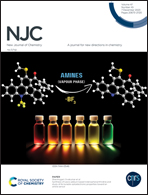Aerosol-assisted chemical vapor deposition of MSe and MSSe thin films using zinc(ii) and cadmium(ii) single source precursors containing hybrid Se,X-PNC ligands†
Abstract
Homoleptic zinc(II) and cadmium(II) complexes containing hybrid N-selenophosphinoylchalcogenoureato ligands, [M(iPr2P(Se)NC(X)NC5H10-κ2-Se,X)2] (M = Zn, X = S (3), X = O (4) and M = Cd, X = S (5)) and [Cd(iPr2P(Se)NC(O)NC5H10)2-μ-O,O]2 (6), were synthesized and characterized by elemental analysis, IR and NMR spectroscopy. SCXRD molecular structures of complexes revealed bidentate ligands bonded to the metal center in a distorted tetrahedral coordination geometry for 4 and 5, while 6 exhibited a dinuclear centrosymmetric structure with a distorted trigonal bipyramidal coordination. Based on thermogravimetric analysis (TGA), the complexes (3–6) were tested as single source precursors (SSPs) to prepare metal chalcogenide thin films by aerosol-assisted chemical vapor deposition (AACVD) at 450 °C (annealing at 600 °C) and 375 °C. 4 and 6 produced good quality hexagonal MSe thin films (4F and 6F), while, remarkably, 3 and 5 deposited the corresponding ternary hexagonal MSSe thin films (3F and 5F) with S contents of 15.8% for 3F and 1.8% for 5F (EDXA). This was confirmed by X-ray photoelectron spectroscopy (XPS) and energy dispersive X-ray analysis (EDXA), from which the elemental composition was also determined. The as-deposited thin films displayed a phosphorus content between 2.0 and 4.4%, while zinc-containing precursors produced zinc-rich thin films. The surface morphologies of 3F–6F were examined by scanning electron microscopy (SEM) and atomic force microscopy (AFM), showing quasi-spherical particles in columns. The optical properties suggest good crystalline quality of as-deposited thin films. The band gaps (Eg) of MSSe films were higher than those of MSe materials. PL spectra of Cd-containing films showed a dominant emission band with a maximum between 1.69 and 1.76 eV related to near-band-edge (NBE) emission, while Zn-containing films showed broad PL signals at ca. 2.0–2.4 eV that could be associated with structural defects. All Raman spectra showed multiple LO phonon overtones, and MSSe solid solutions (from 3 and 5) showed both expected LO scattering modes (MSe-like and MS-like phonons).



 Please wait while we load your content...
Please wait while we load your content...